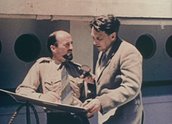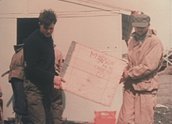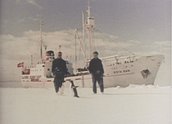


Antarctic Voyage (1956)
Synopsis
At the port of Melbourne, a small Danish ship prepares for a voyage south. The Kista Dan will take 15 men to spend 1955 at the Australian Antarctic research base at Mawson station. Food, fuel, beer and special over-snow vehicles called Weasels are loaded by hand as the incoming Officer-in-Charge, John Bechervaise, arrives to join the ship. Families wave goodbye as the ship leaves on the first leg of an intended 19,000 km voyage, via Heard Island and Princess Elizabeth Land to Mawson. Captain Hans Petersen demonstrates the use of a sextant to plot the ship’s position, as members of the Australian National Antarctic Research Expedition (ANARE) settle into their tasks – taking weather measurements, preparing plans, checking supplies and securing the ship against the increasingly rough weather. After 16 days, the ship arrives at Heard Island, a bleak and spectacular outcrop in the Indian Ocean, halfway to South Africa. The men set to work dismantling the Australian research station set up seven years earlier. Resources are now focused on building a second Australian base on the Antarctic continent.
The ship heads to Princess Elizabeth Land to look for a suitable site. Expedition leader and director of the Antarctic Division, Phillip Law, leads a team of surveyors, biologists and geologists ashore at the Vestfold Hills to survey the area. At the Larsemann Hills, the ship wedges itself into an ice floe and offloads a Weasel and a specially built over-snow ‘caravan’. Law leads another group out to explore the coastline, but the ice is unsafe. The shore party returns just in time to see the ice break up behind them. Another shore party narrowly escapes unstable ice, so the ship heads for Mawson on the coast of Mac. Robertson Land.
The men who have spent a long year at the base are soon enjoying their first letters from home. Serious work begins, unloading the 450 tons of cargo, and building new prefabricated huts. The building program is a race against time; the new huts must be erected and secured against the wind in just one day. Work continues night and day while the weather allows. The scientific programs also continue, as each member of the new team gets an introduction to his working conditions on the base. Phillip Law leads a small group to investigate and map nearby Mt Henderson. After three weeks of hard work, Kista Dan weighs anchor and heads for home, leaving the new party of 15 men alone for the coming year, in Australia’s remotest outpost.
Curator’s notes
For most of its first 19 years, the Antarctic Division was dominated by one man, Phillip Garth Law. He was ambitious, energetic, demanding, patrician in personality and tastes, but tough as nails – a former university boxer and pioneering skier with a taste for risk and adventure, both of which were to get him into trouble. He was also controversial, competitive and given to rubbing people the wrong way. With this film, those traits were to have serious repercussions.
From 1947, when he joined as scientific officer, until his retirement in 1966, Phillip Law was ‘Mr Antarctica’, as one newspaper dubbed him. Trained as a physicist, he was determined that science should be the most important factor in guiding Australia’s work in Antarctica, rather than politics. That brought him into conflict with his superiors in the Department of External Affairs, for whom Antarctic science was just a smokescreen.
In 1933, Australia had made what some writers have called an absurd claim for ownership of 42 per cent of all Antarctic territory. Phillip Law argued that if Australia was to justify its claim, it had to occupy that territory and do meaningful scientific work. Within the Department of External Affairs, the accent was on ‘occupy’, not science. The new Minister for External Affairs, Richard Casey, had some sympathy with Law’s aims, but some of his mandarins, notably the deputy secretary Keith Waller, did not. ‘As you know, I do not think of our Antarctic effort as a scientific expedition’, Waller wrote to Law on 24 March 1955. ‘To me the scientific work is secondary to the political consideration of maintaining our claim in this territory.’
Both Casey and Waller were concerned that Phillip Law was running the division as his personal fiefdom, ignoring departmental regulations about speaking to the press and playing the department off against the Antarctic Executive Planning Committee, where most of the division’s strategies and policies were formulated, before going to the Department of External Affairs for approval. Sir Douglas Mawson, who sat on the committee, privately agreed with Casey and Waller that Law needed reining in. Mawson had always thought that the Australian exploration and scientific effort should be concentrated more in the eastern part of Australia’s claim. Law understood Mawson’s attachment to this area, because Mawson had been the first to explore much of it, but he regarded that view as sentimental. The western half of Australia’s claim was more promising for science and exploration, and that’s where Law established Australia’s first permanent station. Calling it Mawson was both a recognition of the legend and an irony, in the circumstances.
When Phillip Law returned from the most frightening southern journey of his life (see Blue Ice, 1954) in March 1954, he found himself in a different kind of storm. The department moved to undermine the authority of the Executive Planning Committee, which Law chaired. Law told Keith Waller to tell Casey that if they went ahead he would immediately resign. The department backed off, but Casey became the chair of an enlarged committee, which now included representatives of Treasury and the Department of External Affairs. Some of these tensions were personal and somewhat petty. After an Executive Planning Committee meeting in December 1954, Law screened Blue Ice for the committee. Law was justifiably proud of the film, most of which he had shot. Law then invited the committee members to lunch, but Waller declined. He wrote to a colleague: ‘I refuse on principal (sic) because it is much harder to argue with the man if he has just bought you a good lunch.’
Phillip Law was becoming more assertive. He had been running the division for more than seven years, with major achievements to his credit. He felt, with some justification, that the Australian bases at Mawson, Macquarie and Heard Island were better organised, better equipped and more productive in scientific work than those of any country with a claim on Antarctica. Most of that was his doing. He prided himself on being a leader of men, capable of working harder than anyone in his team. That pride was about to be questioned.
Antarctic Voyage documents the 1955 resupply voyage. It was shot on 35mm, which was unusual for any postwar Antarctic film. There is raw footage showing the cameraman George Lowe using a 35mm camera (a Newman Sinclair Autokine, probably dating from around 1946, the favoured camera of many documentary shooters at the time). Lowe worked for the News and Information Bureau of the Department of the Interior. Lowe went south as official photographer, a role Law had reserved for himself on most of the previous voyages. Law had also consented – against his instincts – to take a News and Information Bureau journalist, Tom Hungerford, who would write the film’s commentary. Law had vowed never to take another journalist south, after clashing with Jack Atkinson during the 1949 voyage to Heard Island (see Antarctic Vigil, 1952).
The resupply voyage was an annual event and the major focus of the Antarctic Division’s year. Phillip Law led these expeditions, his authority shared only with Captain Hans Petersen, master of the chartered Danish ship, MV Kista Dan. Even that was begrudging: Law had insisted in the terms of the charter that Petersen could only disregard Law’s directions if the ship or its crew were in danger. Relations between Petersen and Law had recovered somewhat from a year earlier, when they had reached an almost complete rupture (see Blue Ice, 1954).
The main purpose of any Antarctic resupply voyage was to take a new team to replace those returning from a year at Mawson. The other aim was to explore the continent’s largely uncharted coastline. This voyage had a third task that was less popular: in order to increase resources in Antarctica, Law had agreed to close the base at Heard Island.
In 1954, Law had outlined an ambitious five-year plan for the division’s activities, timed to coincide with the coming International Geophysical Year, a major scientific event timed for 1957–58. The IGY would bring together scientific research across the planet, with a major emphasis on Antarctica. Law saw it as the perfect opportunity to grow the Antarctic Division’s scientific programs and cement their funding. Unfortunately, his boss Richard Casey did not fully agree. Law’s five-year plan never reached Cabinet, although much of it got qualified approval from Casey. The most significant decision, at least for Law, was that the government agreed to set up a second base on the Antarctic mainland. The price was that Heard Island would have to be closed.
The first part of Antarctic Voyage documents that melancholy task, after an unusually long introduction showing the ship’s departure from Melbourne. The production values are high in this film, and well thought out. It is clear that it is the work of professionals, rather than enthusiastic amateurs. The story is well structured and the point of view is different to the films shot by Law. Lowe and Hungerford were very experienced; both had served in the Second World War with distinction, and Lowe had just returned from a traumatic period covering the Korean War. They knew their jobs.
This was, in that sense, a fully professional film about the activities of the Antarctic Division, arguably the first. Phillip Law, though an experienced photographer, was not a trained filmmaker. Even so, he had produced some remarkable films, chiefly Blue Ice (1954), which would go on to win an international award later in 1955. As far as he was concerned, both George Lowe and Tom Hungerford were working for him, rather than the Department of the Interior. That meant that they must do as he said, like every other member of the expedition. In George Lowe’s case, he was expected to help unload the ship, as well as photograph. Hungerford was expected to write general news despatches at Law’s request. According to Kathleen Ralston’s second volume of biography (named Phillip Law: The Antarctic Exploration Years 1954-66, 1998, ISBN 0 644 38318 6), Hungerford told Law that his editor had instructed him to send ‘only items of special importance suitable for a minister’s release’.
Law told Hungerford that this was not the idea of having a journalist on the trip and that he wanted a continuous news cover, only part of which would ultimately bear the minister’s name. Law said that he would take full responsibility and, to Law’s mind, ‘Hungerford readily agreed to do as I wished’. Hungerford, in fact, was most upset at Law’s interference in his despatches, as later events would show.
After an eventful but successful voyage, the ship returned safely to Melbourne on 22 March 1955. Law wrote that he was pleased with the way his team had worked and that relations were now much better with the captain. He was also pleased with the two film personnel. ‘George Lowe has filmed the whole voyage and it should make a magnificent film; Tom Hungerford has worked hard giving journalistic coverage to all of our activities.’
In fact, a week later, Hungerford went to see Keith Waller, the assistant secretary of the Department of External Affairs, to complain that Law had censored his despatches and rewritten them ‘in a form which bore virtually no relation to the original’. Hungerford also criticised Law’s personality and leadership, claiming that the expedition was run with ‘a reckless disregard for life and equipment’, and that ‘Law was so intent on scoring personal triumphs that he had no regard to the safety of his men or the best use of his equipment’. Law, he said, ‘was arrogant, self-willed and inconsequent’.
Waller passed these complaints immediately to his minister, Richard Casey. Casey asked Waller to get a second opinion so Waller called in George Lowe, who confirmed Hungerford’s complaints. Law was ‘reckless, tactless, arrogant and entirely oblivious of the problems of handling men’, according to Lowe. ‘He did not command the respect or loyalty of any of the members of any of the parties’, Lowe had said. Lowe complained that Law had taken more photographs during the voyage than Lowe, because ‘he (Lowe) was put on one of the construction teams and could only take pictures in moments of leisure’.
Casey then asked Waller to check with Bob Dovers, who had been Officer-in-Charge at Mawson the previous year. Law and Dovers had clashed many times. Law felt that Dovers was egotistical and resented Law’s control over him. Waller might have expected Dovers to confirm the complaints, but he did the opposite. He told Waller that Law ‘has done a magnificent job in organising the Antarctic Division and the various expeditions’. He felt that Law tended to drive the team too hard during the landing operations ‘but the whole exercise is a race against time and this is perhaps not a bad fault’.
Of all this, Phillip Law knew nothing. He was never told about the complaints, nor given the chance to address them. At the time, he had asked Casey and Waller to approve his request to go as Officer-in-Charge for Mawson Station during the IGY, in 1957–58. ‘Wintering over’ was perhaps the only thing that Phillip Law had not done as director of the division and it left a gap in his experience. It was also true that there was a certain cachet attached to having wintered in Antarctica that Law could not yet share. It’s impossible now to know if the complaints by Hungerford and Lowe had any impact on Casey’s thinking, but he did refuse permission for Phillip Law to go as Officer-in-Charge.
In retrospect, it was perhaps inevitable that Phillip Law would eventually run up against the limits of his own power. This was already happening within the Department of External Affairs before the complaints by the two journalists. Law’s leadership within the division was largely unchallenged, although it was constantly discussed, often in humorous terms, amongst team members. Outside that domain, his behavior was often considered unconventional and defiant, especially by servants of the government. In 1954, he ran up against real power, in the hands of Richard Casey and the senior echelons in Canberra. They appear to have been determined to curb him and they did, by taking control of the Executive Planning Committee and blocking his path to Cabinet approval of his five-year plan. Casey may also have protected him from the likes of Keith Waller, because Casey admired his drive and vision.
Antarctic Vigil has a few ripples of these undercurrents. The filmmakers chose John Bechervaise, rather than Law, as the leading personality of the story, but that decision would have predated the expedition. Bechervaise was the new Officer-in-Charge at Mawson for 1955. In clip one, we see Phillip Law giving an interview on the dock before the ship leaves Melbourne. He outlines the route, but we don’t hear his voice – indeed, we hear no-one else’s either, as the film has a compiled soundtrack, done later in a studio. But there is a subtle reduction in Law’s visibility later in this film. In earlier films he was always in the foreground, but here he is barely seen. It is not clear if Law ever noticed it. Kathleen Ralston writes that he did not know until many years later that Hungerford and Lowe had complained about him, nor that there had been a clandestine review of his performance at the top levels of the Department. Whether it stopped him from becoming Officer-in-Charge at Mawson is impossible to know, but that was a keen disappointment for Law. It meant that he could never join the elite group that he had done so much to establish.
- Overview
- Curator’s notes
- Video 3 clips
- Principal credits
- Find a copy
- Make a comment
- Map
- Add your review



